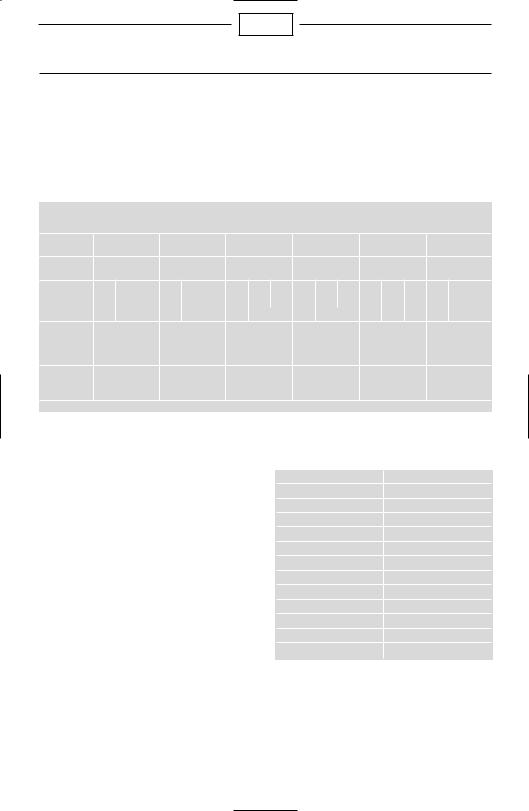STEINEL HG 2510 ESD User Manual

HL 1610 S HL 1810 S HL 1910 E HL 2010 E HG 2310 LCD HG 2510 ESD
i

English
IMPORTANT SAFETY INSTRUCTIONS
READ THESE INSTRUCTIONS
UL WARNING: Read this instruction book before using. To reduce risk of fire or electric shock, do not expose to rain or moisture. Store indoors. Double insulated. When servicing, use only identical replacement parts. When using electric tools, basic safety precautions should always be followed to reduce risk of fire, electric shock and personal injury. This hot air gun operates at 1200°F with no visual indication of temperature (no flame). Never leave device unattended. Otherwise risk of fire. The heat stream at the outlet nozzle will burn flesh. Do not turn on heat gun with hand in front of nozzle. DO NOT USE NEAR COMBUSTIBLE LIQUIDS. DO NOT USE FOR: ● Heating gas engines ● Heating car batteries ● Thawing refrigerator equipment.
WARNING: Some dust created by power sanding, sawing, grinding, drilling and other construction activities contains chemicals known (to the State of California) to cause cancer, birth defects, or other reproductive harm. Some examples of these chemicals are:
●lead from lead-based paints,
●crystalline silica from bricks and cement and other masonry products, and
●arsenic and chromium from chemically-treated lumber.
Your risk from these exposures varies, depending on how often you do this type of work. To reduce your exposure to these chemicals: work in a well ventilated area, and work with approved safety equipment, such as those dust masks that are specially designed to filter out microscopic particles.
WARNING!
This tool is capable of producing temperatures up to 1200° F of flameless heat at the nozzle. ALWAYS:
●Direct the heat away from yourself and others.
●Prevent ignition of combustible materials on or near the workpiece.
●Prevent blockage of intake and nozzle openings.
●Keep a fully charged fire extinguisher on hand.
●Allow the nozzle and accessory tips to cool to room temperature before storage.
Cautions
1.WARNING: Hidden areas such as behind walls, ceilings, floors, soffit boards and other panels may contain flammable materials that could be ignited by the heat gun when working in these locations. The ignition of these materials may not be readily apparent and could result in property damage and injury to persons. Do not use if in doubt about this hazard. When working in these locations, keep the heat gun moving in a back-and-forth motion. Lingering or pausing in one spot could ignite the panel or the material behind it.
2.This heat gun can produce up to 1200° F of flameless heat at the nozzle. Do not direct airstream at clothing, hair or other body parts. Do not use as a hair dryer.
3.Do not use near flammable liquids or in an explosive environment (fumes, gases or dust). Remove materials or debris, that may become ignited, from work area.
4.Always hold tool by plastic enclosure. The metal nozzle requires approximately 20 minutes to cool to where it can be touched. Do not touch nozzle or accessory tips until cool.
5.Do not store tool until nozzle has cooled to room temperature. Place tool in a clear area away from combustible materials while cooling.
6.Do not cut off airflow by placing nozzle too close to workpiece. Keep intake vents clean and clear of obstructions.
7.Place tool on a level surface with the support rubber ring when tool is not hand held. Place cord in a position that won’t cause tipping.
8.Do not leave tool unattended while running or cooling down. Otherwise risk of fire.
9.Keep a fully charged fire extinguisher nearby.
10.Do not direct airflow directly on glass.
11.Shield materials around the heated area to prevent damage or fire.
12.Use only with 120 V AC voltage.
13.Do not use in wet conditions.
14.Not to be used by children. This is not a toy and should be respected.
15.Do not use in bath or over water.
16.Safety glasses should be worn when using this tool.
17.It is recommended that leather gloves be worn when using a heat gun.
-2 -

English
18.Always unplug after use.
19.WARNING: Extreme care should be taken when stripping paint. The peelings, residue and vapors of paint may contain lead, which is poisonous. Any pre-1977 paint may contain lead and paint applied to homes prior to 1950 is likely to contain lead. Once deposited on surfaces, hand to mouth contact can result in the ingestion of lead. Exposure to even low levels of lead can cause irreversible brain and nervous system damage; young and unborn children are particularly vulnerable. Before beginning any paint removal process you should determine whether the paint you are removing contains lead. This can be done by your local health department or by a professional who uses a paint analyzer to check the lead contact of the paint to be removed. LEAD-BASED PAINT SHOULD ONLY BE REMOVED BY A PROFESSIONAL AND SHOULD NOT BE REMOVED USING A HEAT GUN.
Persons removing materials should follow these guidelines.
1.Move the work piece outdoors. If this is not possible, keep the work area well ventilated. Open the windows and put an exhaust fan in one of them. Be sure the fan is moving the air from inside to outside.
2.Remove or cover any carpets, rugs, furniture, clothing, cooking utensils and air ducts.
3.Place drop cloths in the work area to catch any residue. Wear protective clothing such as extra work shirts, overalls and hats.
4.Work in one room at a time. Furnishings should be removed or placed in the center of the room and covered. Work areas should be sealed off from the rest of the dwelling by sealing doorways with drop cloths.
5.Children, pregnant or potentially pregnant women and nursing mothers should not be present in the work area until the work is done and all clean up is complete.
6.Wear a dust respirator mask or a dual filter (dust and fume) respirator mask which has been approved by the Occupational Safety and Health Administration (OSHA), the National Institute of Safety and Health (NIOSH), or the United States Bureau of Mines. These masks and replaceable filters are readily available at major hardware stores. Be sure the mask fits. Beards and facial hair may keep masks from sealing properly. Change filters often. DISPOSABLE PAPER MASKS ARE NOT ADEQUATE.
7.Use caution when operating the heat gun. Keep the heat gun moving as excessive heat will generate fumes which can be inhaled by the operator.
8.Keep food and drink out of the work area. Wash hands, arms and face and rinse mouth before eating or drinking. Do not smoke or chew gum or tobacco in the work area.
9.Clean up all removed residue and dust by wet mopping the floors. Use a wet cloth to clean all walls, sills and any other surface where residue or dust is clinging. DO NOT SWEEP, DRY DUST OR VACUUM. Use a high phosphate detergent or trisodium phosphate (TSP) to wash and mop areas.
10.At the end of each work session put the residue and debris in a double plastic bag, close it with tape or twist ties, and dispose of properly.
11.Remove protective clothing and work shoes in the work area to avoid carrying dust into the rest of the dwelling. Wash work clothes separately. Wipe shoes off with a wet rag that is then washed with the work clothes. Wash hair and body thoroughly with soap and water.
SAVE THESE INSTRUCTIONS
- 3 -

English
Double Insulated Tools
Tools marked with the words “Double Insulated” are equipped with a two prong plug. These tools have a special insulation system that complies with applicable UL standards




 . They do not require grounding. ”Double Insulated” tools, like this one, have two prong cords and can use either a two or three prong extension cord.
. They do not require grounding. ”Double Insulated” tools, like this one, have two prong cords and can use either a two or three prong extension cord.
“This appliance has a polarized plug (one blade is wider than the other). To reduce the risk of electric shock, this plug is intended to fit in a polarized outlet only one way. If the plug does not fit fully in the outlet, reverse the plug. If it still does not fit, contact a qualified electrician. Do not modify the plug in any way.”
Extension Cords
As the distance from the supply outlet increases, heavier gauge extension cords are required. The use of extension cords of inadequate size wire causes a serious drop in voltage and loss of power. Protect the cord from damage. Keep cords away from excessive heat, sharp edges and damp or wet areas. Repair or replace damaged extension cords before using.
Ext. Cord Length |
Wire Size |
|
|
040 Ft. |
16 |
085 Ft. |
14 |
100 Ft. |
12 |
170 Ft. |
10 |
270 Ft. |
08 |
400 Ft. |
06 |
650 Ft. |
04 |
|
|
Note: The HG 2510 ESD is not ”Double Insulated”. It utilizes a 3-prong grounded plug and, for safety, must only be used with a 3-prong extension cord.
- 4 -

English
Thank you
for deciding to choose a STEINEL heat gun. This tool can be used for completing a wide range of jobs safely and reliably, such as soldering, welding PVC, shaping,
drying, shrink-fitting, stripping paint etc. All STEINEL tools are manufactured to the highest standards and undergo a strict process of quality control.
Used in the proper manner, this heat gun will give you lasting satisfaction.
Technical specifications
|
HG 2510 ESD |
HG 2310 LCD |
HL 2010 E |
|
HL 1910 E |
|
HL 1810 S |
HL 1610 S |
|||||||
Voltage |
120 V, 60 Hz |
120 V, 60 Hz |
120 V, 60 Hz |
|
120 V, 60 Hz |
|
120 V, 60 Hz |
|
120 V, 60 Hz |
||||||
Output |
1600 W |
|
1600 W |
|
1500 W |
|
|
1500 W |
|
1400 W |
|
1300 W |
|
||
Switch stage |
1 |
2 |
1 |
2 |
1 |
2 |
3 |
1 |
2 |
3 |
1 |
2 |
3 |
1 |
2 |
Airflow (cf/min.) |
3.6 |
3.6 – 17.6 |
3.6 |
3.6 – 17.6 |
3.6 |
10.6 |
17.6 |
3.6 |
10.6 |
17.6 |
3.6 |
10.0 |
15.9 |
8.5 |
14.8 |
Temperature |
120 ° |
120 – 1200 °F |
120 ° |
120 – 1200 °F |
120 ° |
120 – 1150 °F |
120 ° |
120 – 1100 °F |
120 ° |
750° |
1100 °F |
575 ° |
950 °F |
||
Controls |
pushbutton |
pushbutton |
pushbutton |
|
temperature dial |
|
|
|
|
|
|
||||
|
air/temperature control |
air/temperature control |
temperature control |
|
|
|
– |
|
|
– |
|
||||
|
in 10 °F increments, |
in 10 °F increments, |
in10 °F increments, |
|
|
|
|
|
|
|
|
||||
|
with LCD display |
with LCD display |
with LCD display |
|
|
|
|
|
|
|
|
|
|||
Programs |
4 preset programs, |
4 preset programs, |
|
|
|
|
|
|
|
|
|
|
|
||
|
with ”LOC” Lockable |
with ”LOC”Lockable |
– |
|
|
– |
|
|
– |
|
|
– |
|
||
|
Override Control™ |
Override Control™ |
|
|
|
|
|
|
|
|
|
|
|
||
Subject to technical modifications
Conversion °C to °F
°C |
= °F |
100 |
212 |
200 |
392 |
300 |
572 |
400 |
752 |
500 |
932 |
600 |
1112 |
700 |
1292 |
|
|
Conversion °F to °C
°F |
= °C |
100 |
38 |
200 |
93 |
300 |
149 |
400 |
204 |
500 |
260 |
600 |
316 |
700 |
371 |
800 |
427 |
900 |
482 |
1000 |
538 |
1100 |
593 |
1200 |
649 |
- 5 -

English
Features - Getting started
Please note: The distance from the object you are working on depends on material and intended method of working. Always try out the airflow and temperature on a test piece first! Using the attachable accessory nozzles (see accessories page on the cover) the flow of heat can be controlled with maximum precision.
Take care when changing hot nozzles! When using the heat gun in the self-resting position, make sure it is standing on a stable, non-slip and clean surface.
HL 1610 S
The tool is switched ON and OFF at the two-stage switch on the back of the grip handle. Airflow and temperature can be adjusted to 2 settings. Stage 1 reaches 575 °F at an air flow of 8.5 cf/min, stage 2 reaches 950 °F at 14.8 cf/min.
HL 1810 S
The tool is switched ON and OFF at the three-stage switch on the back of the grip handle. Airflow and temperature can be adjusted to 3 settings. Stage 1 is a Cool air stage at 120 °F with an airflow rate of 3.6 cf/min. Stage 2 reaches 750 °F at an airflow of 10.0 cf/min., stage 3 delivers 1100 °F at 15.9 cf/min. The outlet protection tube can be removed in order to install the overhead security hanger.
HL 1910 E
The tool is switched ON and OFF at the three-stage switch on the back of the grip handle. In addition to threestage speed/airflow control (stage 1 is a ”Cool-air stage” at 120 °F ), temperature can be continuously adjusted over a range of 120 °–1100 °F at the thumbwheel. The numbers (1 to 9) on the thumbwheel serve as a guide only. Whereas ”1” means 120 °F, the maximum temperature of 1100 °F is attained at ”9”.
Airflow can be adjusted to the three stages of 3.6/10.6/17.6 cf/min. The outlet protection tube can be removed in order to install the overhead security hanger.
Temperature |
Temperature |
Temperature |
Sample |
|||||
Dial Setting |
Range °F |
|
Range °C |
|
Applications |
|||
1 |
100 |
– |
160 °F |
37.8 |
– 71.1 °C |
cleaning surfaces |
||
2 |
200 |
– |
300 |
°F |
93.3 |
– 148.9 °C |
activating adhesives |
|
3 |
375 |
– |
475 |
°F |
190.6 |
– 246.1 °C |
shaping/removing flooring materials |
|
4 |
475 |
– |
575 °F |
246.1 |
– 301.7 °C |
welding PE, LDPE, PP, thawing pipes |
||
5 |
600 |
– |
700 |
°F |
315.6 |
– 371.1 °C |
welding ABS, PBT, PC; lap welding plastic sheeting |
|
6 |
725 |
– |
825 |
°F |
385.0 |
– 440.6 °C |
de-soldering circuit boards |
|
7 |
850 |
– |
950 |
°F |
454.4 |
– 510.0 |
°C |
stripping paint, loosening nuts/screws |
8 |
975 |
– |
1075 |
°F |
523.9 |
– 579.4 |
°C |
de-soldering copper pipes |
9 |
1025 |
– 1125 °F |
551.7 |
– 607.2 |
°C |
soldering |
||
|
|
|
|
|
|
|
|
|
HL 2010 E
The tool is switched ON and OFF at the three-stage switch on the back of the grip handle. In addition to threestage speed/airflow control, temperature can be continuously adjusted over a range of 120 °–1150 °F by the pushbuttons. The target temperature can be increased in 10 °F steps by pressing the ”+” side of the temperature pushbutton or reduced by pressing the ”–” side of the temperature pushbutton. Pressing the button briefly increases or reduces the target temperature by one 10 °F step. Keeping the button pressed will continue to increase or reduce the temperature in steps of 10 °F until the button is released or the minimum or maximum temperature is set.
Blower stage 1 delivers a temperature of 120 °F. The tool will take a short while to cool to 120 °F after switching down to blower stage 1 when it has been operating at high temperatures on blower stage 2 or 3. While the tool is cooling down, the LCD display shows the actual temperature at the nozzle outlet. After switching OFF, the tool stays in the last setting. The outlet protection tube can be removed in order to install the overhead security hanger.
- 6 -
